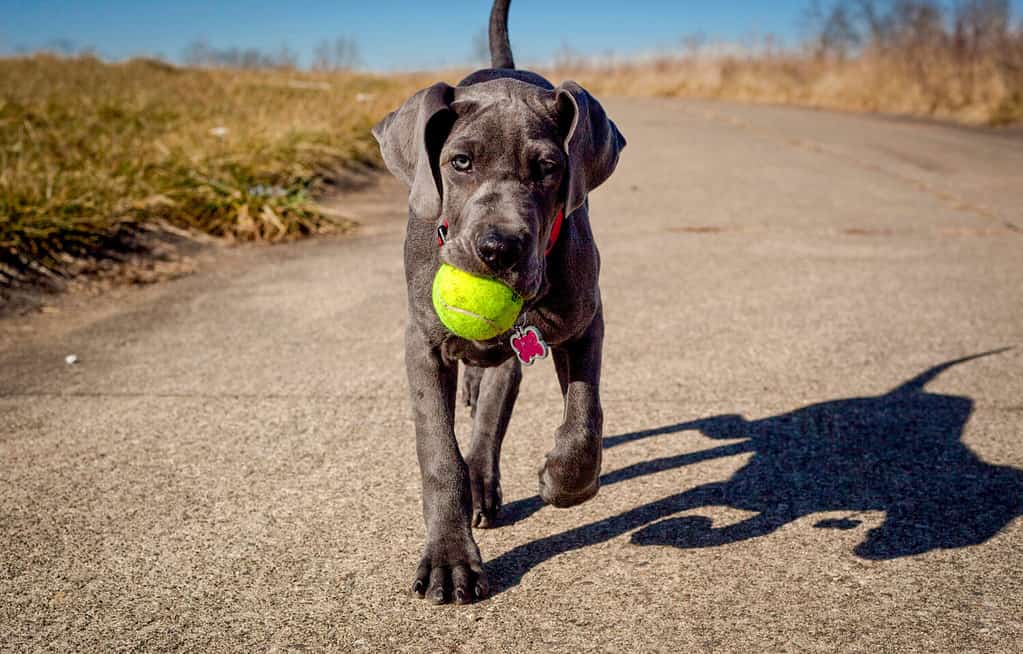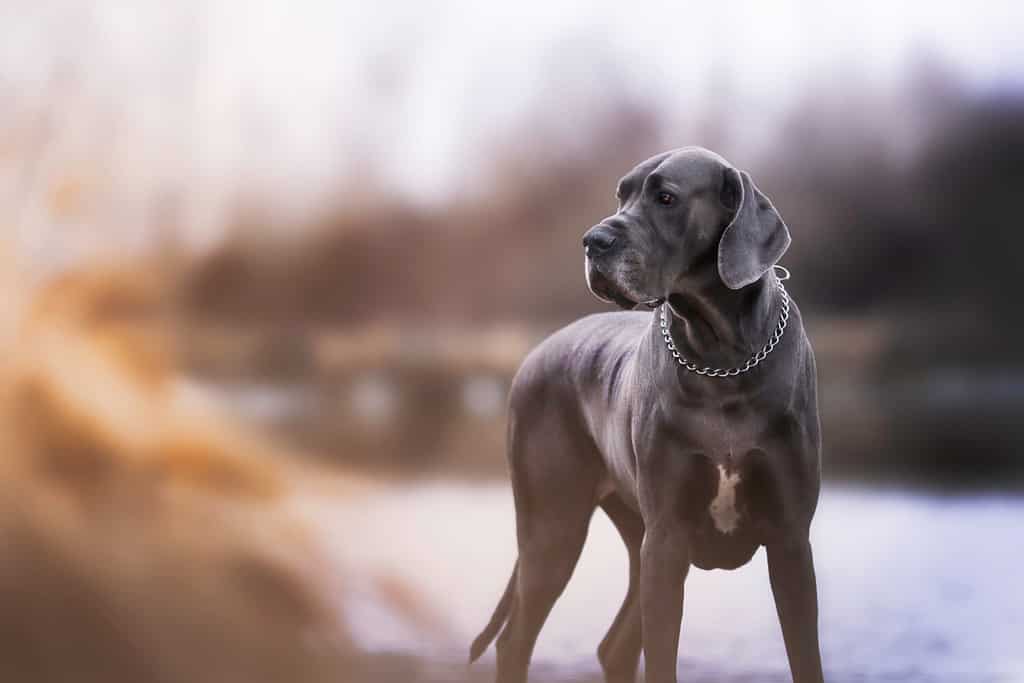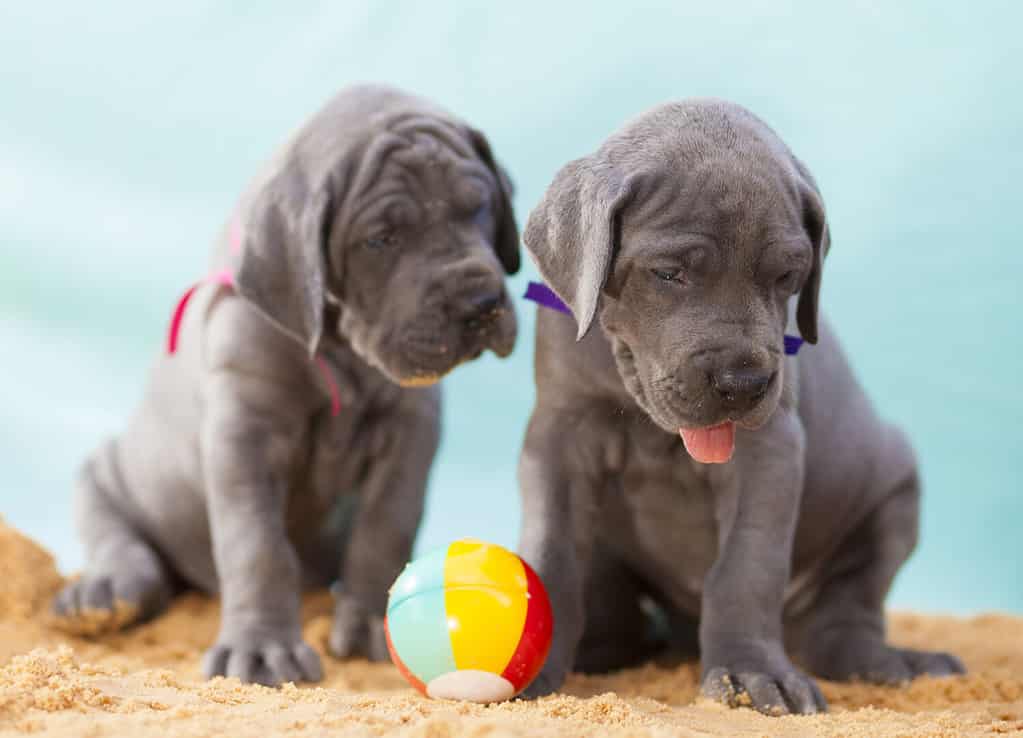Welcoming a Great Dane puppy into your household is an exciting time for many families. This breed has the ability to liven up any home, and it’s easy to get swept away in all the fun! However, there are several things to consider when bringing any new puppy into your home. Determining the appropriate time to neuter or spay your new puppy can be difficult, especially for new dog owners. Today, we’ll discuss three steps to follow when preparing to spay or neuter your Great Dane puppy.
Great Danes: An Introduction to the Breed

Despite being named “Great Dane,” these dogs aren’t actually Danish at all. They were first bred by German nobility as working dogs roughly 400 years ago.
©Guy J. Sagi/Shutterstock.com
Great Danes are elegant and incredible dogs, and owners don’t have enough good to say about them. They are protective, loyal, and highly intelligent, making this breed one of the best in their class. Despite their large stature, Great Danes are still relatively low-maintenance for a breed of their size. They have relaxed temperaments and get along well with young children and other animals. Although they have many wonderful qualities, it is important to keep in mind that a dog this large will require additional care. Great Danes are one of the biggest dog breeds and adults will grow to weigh between roughly 100 and 175 pounds depending on their diet, gender, and age. Make sure the home you live in is equipped for a breed of this size, and that you have enough space for them to grow into.
In addition, those considering welcoming a Great Dane into their household should be aware that training a Great Dane is a time-consuming endeavor. You should start training your Great Dane when they are young, as it will determine their behavior as adults. Starting with simple commands like sit, stay, and roll over will prepare them for more complex ones later on. In addition to mental stimulation, it is just as important to stimulate them physically. Put aside enough time to give them two to three good walks per day and be sure to play with them often. Owners who find themselves away from home often should reconsider adopting this breed, as they have a high need for attention.
1. Consider Your Great Danes Age

On average, Great Danes will live between eight and ten years.
©Dmussman/Shutterstock.com
Unlike other dog breeds, there are special considerations to be made when planning to neuter or spay your Great Dane. Some people report fixing their Great Dane puppies as young as a few weeks old, but this is not common. Most owners advocate waiting until at least one year before neutering or spaying their puppies. But why is this? For many years, owners and breeders shared a belief that this procedure should be delayed for as long as possible. The Great Dane has the ability to grow to incredible sizes, and delaying spaying or neutering would allow extra time for their hormones to regulate. Waiting was believed to prevent medical issues such as hip dysplasia, cancer, and cruciate ligament deficiency.
For many years, the public accepted this as plausible with little evidence to support these claims. However, scientists recently researched this phenomenon and came to a verdict. Researchers at UC Davis surveyed the effects of neutering different dog breeds at a variety of ages and reported on their findings. This paper suggests that the ideal age to neuter or spay varies from breed to breed. For Great Danes, it was found that there was “…no indication of [an] increase in one or more joint disorders with neutering at any age..” Despite this, it is still recommended that “given the large body size, and physiology of late musculoskeletal development, neutering well beyond year 1 should be considered.” Try to consult directly with your veterinarian regarding the ideal age to neuter your Great Dane.
2. Research Reputable Veterinarians

The popular cartoon character Scooby-Doo is a Great Dane.
©verky01/Shutterstock.com
Being aware of the reputation of the veterinarian who will be performing this surgery on your puppy is crucial. Although the risk of fatality is usually very low during this routine procedure, outliers are possible. In order to avoid this, try to seek word-of-mouth recommendations to determine a veterinarian’s reputation. If you don’t know anyone in your personal life to ask, online forums can be helpful. A quick internet search will help you find local groups where you can discuss veterinary practices in your area with other pet owners.
You should never neuter or spay your Great Dane at a veterinarian’s office you do not trust, or one that has poor reviews. In addition, try to steer clear of new practices as well as they will not have a long history of customer satisfaction. It is best to go to well-known, highly-reviewed places that only employ credentialed vets. Doing some research online before booking to proceed will save you a lot of heartache. In the event an accident does occur, your puppy may suffer lifelong complications. Paying a little extra for peace of mind will be worth it.
3. Be Aware of Risks for Complications

Great Danes were originally bred to be hunting dogs due to their high intelligence and athleticism. Since then, they have become more popular as household pets.
©Eric H. Gonzalez/Shutterstock.com
The risk of complications associated with spaying or neutering your Great Dane will rise depending on their age. Neutering too young is often associated with a higher risk of medical issues. If you’re unsure if your puppy is old enough, it is always best to wait. Professionals recommended only scheduling this surgery for Great Danes who are over eight months old at minimum. Generally, the recovery time from this operation is roughly ten days to two weeks. Your Great Dane should not be engaging in any strenuous physical activity during this time, such as running, hiking, or intense playing. Use these days to relax and monitor their recovery, being sure to make note of any abnormalities.
The chance for complications to occur following neutering and spaying is relatively low, between 0 and 30 percent for both males and females. However, it is always best to be prepared in case an emergency does happen. If the site of the wound appears to have any redness, swelling, or bleeding, this can be cause for concern. In the event that your Great Dane appears to be in serious or prolonged pain, seek veterinary help immediately.
Final Thoughts

Great Danes are “gentle giants.” Despite their large stature, these dogs are very loving and have a relaxed temperament.
©Guy J. Sagi/Shutterstock.com
Deciding when to neuter or spay your Great Dane puppy can feel stressful at first. However, this is a common experience, so don’t blame yourself if you feel overwhelmed. Neutering or spaying a large dog breed differs slightly from small to medium-sized dogs, and it is not uncommon to be confused by the process. Even experienced dog owners will likely have questions.
The ideal age to fix your puppy depends on a variety of factors and will vary on a case-to-case basis. Unfortunately, there isn’t a “one-size-fits-all” answer. That being said, it’s important for your puppy to undergo this procedure, as it will greatly lower the risk for diseases such as ovarian and testicular cancer later on in life. It’s important to wait until they’re old enough, but not to delay too long. As always, it’s recommended to speak to a veterinary professional who can assess your Great Dane’s personal needs to determine when they will be ready for this surgery.
The photo featured at the top of this post is © Guy J. Sagi/Shutterstock.com
Ready to discover the top 10 cutest dog breeds in the entire world?
How about the fastest dogs, the largest dogs and those that are -- quite frankly -- just the kindest dogs on the planet? Each day, AZ Animals sends out lists just like this to our thousands of email subscribers. And the best part? It's FREE. Join today by entering your email below.
Thank you for reading! Have some feedback for us? Contact the AZ Animals editorial team.







